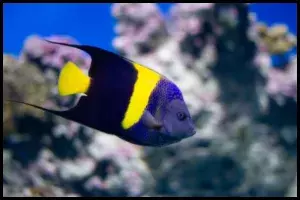
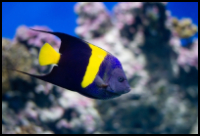
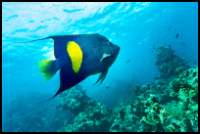
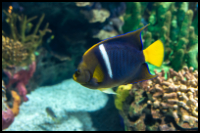
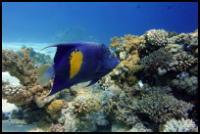
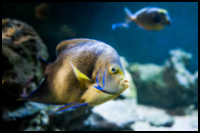
Quick Care Details (Table)
| Livestock Characteristics | Value |
|---|---|
| Care Level | Easy |
| Temperament | Semi-Aggressive |
| Diet | Omnivore |
| Maximum Size | 1ft & 4 Inches |
| Minimum Tank Size | 150 Gallons |
| Reef Compatible | With Caution |
| Temperature Range | 72-78F |
| PH Range | 8.1-8.4 |
| DKH Range | 8-12 |
| Salinity Range | 1.020-1.025 |
Species Specific Categories
Helpful Video
Care Details
Aquascape: When setting up the tank for Asfur Angelfish, think of it as their underwater home. Create spaces with caves and crevices among live rocks for them to explore and find shelter.
Substrate: Choose a fine substrate like sand or crushed coral. This allows the fish to exhibit their natural behavior of sifting through the substrate in search of food. Keep it deep enough for digging but not so deep that it traps debris.
Disease Prevention: To keep your Asfur Angelfish healthy, maintain good water quality. Regular water changes, quarantine for new additions, and a balanced diet go a long way in disease prevention.
Filtration: Invest in quality filtration to ensure clean water. A protein skimmer helps remove organic waste, while a robust mechanical and biological filter keeps the tank environment stable.
Lighting: These angelfish don't require intense lighting. Opt for moderate lighting that suits the needs of other tank inhabitants, as Asfur Angelfish isn't particularly dependent on bright lights.
Water Flow: Asfur Angelfish prefer tanks with good water movement, similar to their natural habitat. You can achieve this by using powerheads or water circulation pumps to create gentle water flow.
Hardiness: Asfur Angelfish are moderately hardy. However, due to their specific dietary preferences and potential for aggression, they are better suited for experienced aquarists.
Acclimation: When introducing them to a new environment, take it slow. Gradually acclimate them to the tank water over an hour to reduce stress.
Expected Lifespan: With proper care, Asfur Angelfish can live up to 10-15 years in captivity. This means they're a long-term commitment in your reef tank.
Special Requirements: These fish have unique dietary needs, favoring sponges and invertebrates. You'll need a well-established, sizable tank with plenty of live rock for grazing. Be aware that Asfur Angelfish can be territorial and may display aggression toward similar-looking angelfish species. So, choose their tank mates thoughtfully to avoid conflicts.
Temperament and Behavior
Behavior and Social Interaction: Asfur Angelfish are known for their curious and active nature. They enjoy exploring their surroundings and often establish territories within the tank. They can be seen swimming around, inspecting rocks and crevices, and displaying their striking colors. While they're not typically considered schooling fish, they do well in pairs or small groups.
Aggression: These angelfish can exhibit territorial and aggressive behavior, especially toward fish of similar body shapes or coloration. It's important to introduce them to the tank last or rearrange the aquascape when adding new fish to reduce territorial disputes.
Breeding: Breeding Asfur Angelfish in captivity can be challenging due to complex reproductive behaviors. They are hermaphrodites, meaning they possess both male and female reproductive organs. If a mated pair is established, they may spawn and produce pelagic eggs that drift in the water column.
Compatibility with Inverts and Fish: Asfur Angelfish can coexist with some invertebrates but may nip at soft and stony corals. Choose tank mates carefully, avoiding other angelfish species or those with similar body shapes. Some compatible tank mates include tangs, surgeonfish, and some larger wrasse species.
Activity Level: These angelfish are relatively active swimmers. They spend their time patrolling their territory, grazing on algae, and exploring the aquarium. Their constant movement adds vitality to the tank.
Clean-Up Crew: Asfur Angelfish can contribute to your tank's "clean-up crew" by grazing on algae growth. They help control algae in the aquarium, although they should not be relied upon as the sole algae-eating species.
Schooling or Shoaling Behavior: Asfur Angelfish are not typically known for schooling or shoaling behavior. They are more individualistic and tend to form pairs or small groups rather than large schools.
Coral Reef Compatibility: Asfur Angelfish can be kept in reef tanks with caution. While they may not harm most corals, there's a risk of them nipping at some soft and stony corals. Monitor their behavior and, if necessary, consider coral selection accordingly.
Diet and Nutrition
Dry Foods: Asfur Angelfish can accept high-quality marine flake and pellet foods as part of their diet. These are convenient and provide essential nutrients. However, they should be supplemented with other food types for a balanced diet.
Frozen Foods: Frozen foods are a delightful addition to their diet. Offer a variety of options such as brine shrimp, mysis shrimp, and other marine preparations. These provide a varied diet and mimic their natural feeding habits.
Live Foods: Live foods add excitement to their diet. Asfur Angelfish can enjoy live foods like brine shrimp and enriched adult brine shrimp. These mimic their natural hunting behavior and provide essential nutrients.
Vegetables: Asfur Angelfish do not typically consume vegetables, but it's beneficial to offer them marine algae or seaweed. These can be attached to the tank to encourage grazing and help control algae growth.
Algae: Asfur Angelfish have a natural inclination to graze on algae in the wild. Providing them with marine algae or other types of edible algae in the aquarium can help replicate their natural diet.
Feeding Schedule: Maintain a regular feeding schedule with 2-3 small meals a day. This keeps them well-fed and healthy. It's important not to overfeed, as uneaten food can lead to water quality issues. Observe their eating habits and adjust portion sizes as needed.
Supplemental Foods: Consider adding supplemental foods like vitamin-enriched pellets specifically designed for marine angelfish. These can provide an extra nutritional boost, ensuring your Asfur Angelfish receive all the necessary vitamins and minerals for optimal health.
Tank Parameters
Tank Size: When setting up a tank for Asfur Angelfish, think roomy. You'll want a tank of at least 125-150 gallons to give them the space they need. The more significant the tank, the happier they'll be, as they're active swimmers and can get a bit territorial.
Tank Length and Measurements: Choose a tank with dimensions that offer a generous horizontal swimming area. Ideally, aim for a tank that's around 6 feet long, 18 inches wide, and 24 inches tall. This layout suits their swimming and territorial behaviors.
Species Maximum Size: Asfur Angelfish can reach up to about 16 inches in captivity. So, a larger tank allows them to grow comfortably.
Water Temperature: Maintain a consistent water temperature between 72-78°F (22-26°C). This range matches their natural habitat and keeps them comfortable.
pH (Acidity/Alkalinity): Keep the pH level steady between 8.1 to 8.4. A stable pH is vital for their overall health and well-being.
Nitrate (NO3) Levels: Keep nitrate levels relatively low, ideally under 10-20 parts per million (ppm). Regular water changes and an effective filtration system help manage nitrate levels.
Salinity: Asfur Angelfish thrive in marine conditions with a specific gravity of about 1.023-1.025. This level corresponds to slightly saltier water than freshwater. Use a reliable hydrometer or refractometer to monitor and adjust salinity as needed.
Phosphate (PO4): Maintain phosphate levels at the lower end, around 0.03-0.08 ppm. Proper filtration and good water quality practices help in controlling phosphate levels.
Alkalinity (dKH): Alkalinity, often measured in degrees of carbonate hardness (dKH), should be kept between 8-12 dKH. This range contributes to pH stability and the overall health of the tank environment.
History, Popularity, History and Species Variety Details
The History, Popularity, and Natural Habitat
History: The Asfur Angelfish, scientifically known as Pomacanthus asfur, has quite a fascinating story in the world of marine aquariums. This beautiful species was first described back in the 19th century. Its unique appearance and vibrant colors have been captivating fish enthusiasts for a long time. Over the years, it has earned a special place in the hearts of marine aquarium keepers.
Popularity: The Asfur Angelfish is a true celebrity in the world of marine aquariums. Its eye-catching blue and yellow hues, along with its active nature, have made it a sought-after addition to many tanks. However, it's worth noting that their care requirements, such as tank size and diet, can make them a bit challenging for beginners.
Natural Habitat: In the wild, these angelfish call the warm waters of the Red Sea and the western Indian Ocean home. They are often found in coral-rich environments and lagoons, where they seek refuge among the coral formations. Their stunning blue and yellow colors help them blend into the vibrant coral reef ecosystem. Asfar Angelfish are known to graze on algae, sponges, and small invertebrates in their natural habitat.
In their native waters, they play a vital role in the colorful coral reef ecosystems, helping to maintain a balance by controlling algae growth and contributing to the overall health of the underwater world. Understanding their origins and natural behaviors is essential to providing the best care for them in your home aquarium.
In summary, the Asfur Angelfish has a captivating history, is immensely popular in the aquarium hobby, and originates from the breathtaking coral reefs of the Red Sea and the Indian Ocean. Their remarkable colors and behavior make them a mesmerizing addition to marine aquariums but do keep in mind their unique care requirements for a successful experience.
- Rock Beauty Angelfish (Holacanthus tricolor): These angelfish have a vibrant coloration with blue, yellow, and black, which is somewhat reminiscent of the Asfur Angelfish. They are often found in the Caribbean and are popular in the aquarium trade.
- Blueface Angelfish (Pomacanthus xanthometopon): These angelfish have a stunning blue face, which sets them apart from the Asfur Angelfish. However, they share the same genus, Pomacanthus, and can have similar care requirements.
- Emperor Angelfish (Pomacanthus imperator): While Emperor Angelfish have a different color pattern, they belong to the same genus as Asfur Angelfish. Both species have a similar body shape, but Emperor Angelfish are known for their striking blue and yellow stripes.
- Koran Angelfish (Pomacanthus semicirculatus): These angelfish are larger and have distinctive blue and yellow stripes. While their coloration is not the same as Asfur Angelfish, they share the same genus.
- Queen Angelfish (Holacanthus ciliaris): Queen Angelfish are known for their bright blue and yellow colors, making them a visually appealing choice for reef aquariums. They are, however, more challenging to keep due to specific dietary needs.
- French Angelfish (Pomacanthus paru): The French Angelfish has a striking pattern with black and yellow colors on its body. They are found in the Caribbean and can add an exotic touch to your tank.
- Masked Angelfish (Genicanthus personatus): These angelfish have a unique, mask-like pattern on their face and come in various color forms. They're part of the Genicanthus genus and are more peaceful than some other angelfish species.
Frequently Asked Questions
What size tank do they need?
Asfur Angelfish require a spacious tank, ideally with a capacity of 125-150 gallons or larger to accommodate their size and activity.
Are they compatible with other fish?
Carefully choose tank mates, avoiding fish with similar body shapes and overly aggressive species. Tangs and larger wrasse species can be compatible.
What should I feed them?
Offer a varied diet, including marine flakes, pellets, frozen foods like brine shrimp, live foods, and marine algae to ensure they receive essential nutrients.
Do they need a special aquascape?
Create a habitat with live rocks, caves, and hiding spots to replicate their natural environment and provide shelter.
Do they graze on algae?
Yes, Asfur Angelfish are known to graze on algae, helping to control algae growth in the tank.
Are they easy to care for?
Asfur Angelfish are considered moderately challenging due to their specific care requirements. They are best suited for experienced aquarists.
What's their expected lifespan?
With proper care, Asfur Angelfish can live up to 10-15 years in captivity, making them a long-term commitment for your aquarium.
Can I keep them in a reef tank?
Yes, they can be kept in a reef tank, but be cautious as they might nip at soft and stony corals. Monitor their behavior and consider coral selection accordingly.
Are Asfur Angelfish prone to any diseases?
Like other marine fish, they can be susceptible to common saltwater fish diseases such as ich (white spot disease). Maintaining good water quality and quarantine practices for new additions can help prevent diseases.
Do they have any specific breeding requirements?
Breeding Asfur Angelfish in captivity is challenging due to complex reproductive behaviors. They are hermaphrodites and may require specific environmental cues to trigger spawning.
Can I keep them in a fish-only or reef tank?
Asfur Angelfish can be kept in both fish-only and reef tanks. However, in reef tanks, closely monitor their interactions with corals and choose tank mates carefully to avoid any potential conflicts.

